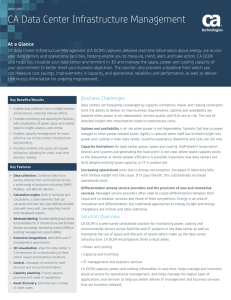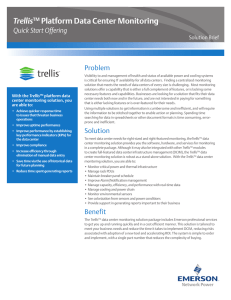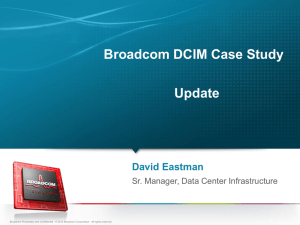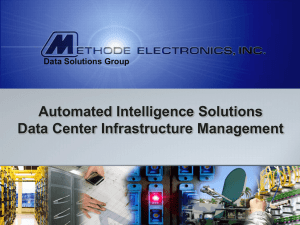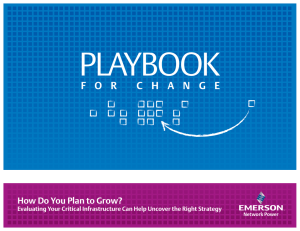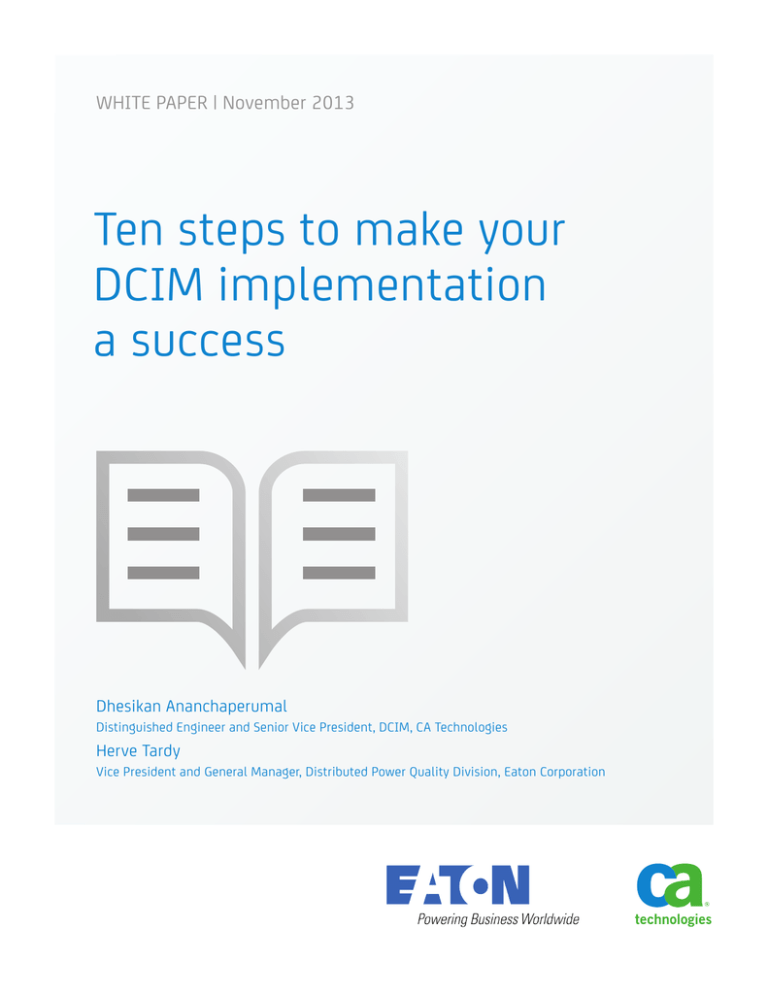
WHITE PAPER | November 2013
Ten steps to make your
DCIM implementation
a success
Dhesikan Ananchaperumal
Distinguished Engineer and Senior Vice President, DCIM, CA Technologies
Herve Tardy
Vice President and General Manager, Distributed Power Quality Division, Eaton Corporation
2 | WHITE PAPER: TEN STEPS TO MAKE YOUR DCIM IMPLEMENTATION A SUCCESS
Table of Contents
ca.com
Executive Summary
3
Achieve maximum value with minimum effort
3
Best practice steps for implementation success
4
Conclusions
10
About the Authors
11
3 | WHITE PAPER: TEN STEPS TO MAKE YOUR DCIM IMPLEMENTATION A SUCCESS
ca.com
Executive Summary
As demands on the data center increase, IT and facilities departments
need to be able to increase and sustain high availability, maximize
e ciency and minimize costs. Data Center Infrastructure Management
(DCIM) provides an integrated platform for monitoring and measuring
consumption, capacity and performance of both IT and facilities resources
in the data center.
For many organizations, 2014 will be the year they implement DCIM.
This practical white paper will also ensure that 2014 is the year they
realize their return on investment from DCIM.
From de ning business needs and setting operational thresholds to
enabling integrations and ensuring scalability, we have taken the
combined expertise of CA Technologies and Eaton, based on lessons
learned from our customers, to provide this best practice implementation
guide to DCIM.
Achieve maximum value with minimum effort
DCIM has crossed the chasm from IT buzzword to business enabler, with more than half of data
center managers recognizing the value of using an integrated DCIM system 1.
Yet only a third of organizations have so far deployed a DCIM solution, with cost and integration
issues being cited as the main adoption barriers2. However, with the right planning, a DCIM
deployment need not be a costly or a complex undertaking. For example, a Fortune 500 bank
implemented CA DCIM in just six weeks in its double tier IV certified data center.
It is important to remember that DCIM is not a one-off project; it’s an ongoing program. As such, an
implementation can be phased with future investment being funded by the savings achieved from
the initial stages.
This practical guide helps organizations determine where to start their DCIM implementation and
how to achieve the best outcomes.
4 | WHITE PAPER: TEN STEPS TO MAKE YOUR DCIM IMPLEMENTATION A SUCCESS
ca.com
Best practice steps for implementation success
1) Validate what you want to achieve
The success of any DCIM implementation will be determined by the specification of the initial
requirements. As one of the major goals of most DCIM implementations is to provide a unified and
granular view of numerous data center information sources, it is important to first understand the
current state of the environment. This is particularly key when assessing existing management
systems. Typically, organizations have around 10 to 40 systems for managing their data centers.
DCIM should not become another addition to this long list.
A DCIM implementation presents organizations with an opportunity to amalgamate and/or retire
existing management tools. To identify optimization opportunities, IT and facilities departments need
to go back to basics and establish:
• Who is using the system and for what purpose?
• How much does it cost to maintain the system?
• What value is the system adding?
• Can I leverage this existing investment as a data feed into DCIM (for example a Building
Management System (BMS) or Electrical Power Management System (EPMS)?
Functionality overlaps will help determine those tools that can be phased out or integrated, with the
end goal being just one or two centralized data center management systems.
2) Stay aligned to the business
From capacity and consumption to availability and recoverability, DCIM solutions can generate an
abundance of performance metrics across the data center. However, a wealth of information doesn’t
necessarily mean a wealth of knowledge.
To ensure a DCIM implementation remains aligned to business goals and priorities, IT and facilities
departments need to take time to identify the metrics that matter: the metrics that will help them
make the data center leaner and greener.
This mapping process, which should happen prior to implementation, will differ between each
organization and each data center. For example, for a managed service provider with a new data
center, the priority might be tracking power consumption to individual devices. For a bank with a
portfolio of facilities, safeguarding availability might represent the primary business metric.
The results of the requirements study will be key to identifying the right performance metrics—of
which there are now plenty. For example, while PUE was once the stalwart for measuring data center
efficiency, it only provides a mere snapshot of the full picture.
To maximize performance and minimize costs in the data center, organizations now need much
broader and deeper metrics—and analytics—that span power availability, IT asset utilization, carbon
emissions and even water consumption.
5 | WHITE PAPER: TEN STEPS TO MAKE YOUR DCIM IMPLEMENTATION A SUCCESS
ca.com
A best-of-breed DCIM solution will be able to generate metrics across this broad spectrum, and adapt to
new industry measures as they emerge. It will also enable IT and facilities departments to implement
their own customized metrics as their implementation matures.
Metric mapping: customer scenario
By taking a business centric approach to its DCIM metrics, a large shipping company has
been able to correlate the costs of data center operations and power consumption to
each container that it transports. With better visibility of its operational costs, the company
can prioritize investments, continuously improve operations and safeguard profitability.
3) Maintain data quality and consistency
Multiple streams of data are the foundation of every DCIM metric. For metrics to be meaningful, data
must be collected in real-time and on a regular - or even continuous - basis. Data capture intervals
will not be the same for every device – and will be influenced by the business needs established in
the initial requirements study.
Smart polling not only overcomes the issue of the frequency of data collection but also the diversity
of data formats. IT and facilities systems use a wide range of protocols - such as Modbus, BACnet and
SNMP - and DCIM solutions need to integrate with all of them. Without this interoperability, data
gaps will start to emerge and metrics will no longer be completely accurate.
The disparity between naming conventions for different variables can also have a major impact on
data accuracy – especially when polling facilities systems. For example, a CRAC unit manufactured by
Vendor A might use the term ‘Inlet Temperature’ while the same device from Vendor B refers to
‘Temp_In’.
DCIM solutions need to detect that these are in fact the same variables and process the data
accordingly. Without this built-in intelligence, organizations will end up with inconsistent data that
demands considerable manual aggregation and is not suitable for granular back-end analytics.
It is also common for facilities equipment to use a ‘scaling factor’. DCIM solutions need to
recognize the different scaling factors being used for different variables and take this into account
when calculating metrics.
By implementing a DCIM solution with such broad functionality and compatibility, organizations can
avoid the need for protocol converters and additional monitoring tools, thereby avoiding unnecessary
cost and complexity.
6 | WHITE PAPER: TEN STEPS TO MAKE YOUR DCIM IMPLEMENTATION A SUCCESS
ca.com
Smart polling: customer scenario
A major insurance company has been able to safeguard service quality by using
its DCIM solution to control polling frequency across different workloads. With
polling throttled for less critical workloads, it is able to focus on capturing granular
data only from core systems. As a result, the data center operations team can see
analytics in real time in the NOC via a DCIM dashboard.
4) Avoid alert overload
More management systems in the data center means more alerts. DCIM solutions can help cut
through this noise – but only if alarms are classified and configured correctly during implementation.
Event correlation is key to suppressing the volume of alerts. Unlike many of today’s disparate data
center management tools, DCIM can aggregate alerts from IT and facilities devices to prevent one
event from being logged as multiple incidents.
By using advanced alerting features, such as ‘time over threshold’ and ‘deviation from normal’,
organizations can prevent every change in operational conditions from raising a false alarm—and
waking the data center manager in the middle of the night. Defining alert profiles based on use cases
is key to establishing this ‘intelligent’ approach and averting alarm overload.
When a genuine alert is raised, organizations need to ensure that their DCIM solutions communicate the
event in terms that are relevant to both IT and facilities. For example, for an alert related to a power
surge, the DCIM solution should communicate the impact on dependent IT systems and business
services/sites. This will enable IT and facilities to collaborate swiftly and effectively to minimize
disruption to end users.
Some DCIM solutions will even go one step further by ‘learning’ the normal behavior of different
devices and thermal conditions in the data center. Given the evolving nature of today’s data centers,
thresholds can rapidly change as new devices are added and cooling and power supplies put under
greater strain.
Intelligent alerting: customer scenario
By deploying DCIM, an MSP has been able to resolve a recurring problem with alarms
related to power spikes in its data center. The alerts, which were raised by a building
management system, did not provide sufficient context to pinpoint the problem. The
MSP has used its DCIM solution to set up intelligent thresholds that prevent the false
alarms from being issued.
7 | WHITE PAPER: TEN STEPS TO MAKE YOUR DCIM IMPLEMENTATION A SUCCESS
ca.com
5) Establish effective integrations
With the average organization using dozens of different tools to manage their data center operations,
integration is a major consideration for any DCIM implementation.
BMS are the most obvious candidates, but this is just the tip of the integration iceberg: service desk
ticketing platforms, fire detection systems, physical security systems and user authentication controls
can all be linked to DCIM. The integrations can be phased-in as different DCIM use cases come into scope.
As well as being the most obvious, DCIM/BMS integration is the most important. When integrating
with a BMS, organizations need to:
Identify the various protocols used for communicating with the BMS and evaluate how they can be
leveraged. For example, there may be web services that can be utilized.
• Establish a secure link for those BMS hosted on an isolated network to facilitate data importing into
the DCIM solution.
• Create a list of key data points and polling frequency based on the use cases defined during the
requirements study.
•
Effective integration will also enable the use of automated workflows, for example for incident and
problem management, which will accelerate response times and free up resources.
Systems integration: customer scenario
When a power strip to a production system failed, it went unnoticed - except by
the company’s DCIM solution. Thanks to the integrations established with other IT
management tools, a service desk ticket was automatically raised and an alert routed to
the monitoring team’s console. As a result, the team was able to take immediate action
to minimize business impact.
6) Protect data and system integrity
Safeguarding the data stored in IT systems is of growing importance – and DCIM is no exception.
Device and facility information could expose unforeseen vulnerabilities to hackers, putting the entire
data center operation at risk.
To ensure IT and facility data stays secure on the network, DCIM systems must be subjected to the
same security measures as other enterprise-level solutions. For example, access should be governed
by user authentication—particularly if DCIM data is being viewed on mobile devices where
authentication, authorization and access control should be handled by an efficient Mobile Device
Management solution.
To support robust identity and access management, organizations should ensure their DCIM solution
integrates with LDAP and Active Directory. Support for secure communication protocols, such as SNMP
v3 and IP v6, plus the ability to encrypt data between integrated systems and polled devices are also
key security considerations.
The DCIM solution’s own alerting functionality can also be used to issue alarms when unusual data
flow patterns or requests are observed.
8 | WHITE PAPER: TEN STEPS TO MAKE YOUR DCIM IMPLEMENTATION A SUCCESS
ca.com
Security is not a ‘tick-in-the-box activity’ and therefore needs to routinely reviewed. In addition to
undertaking vulnerability testing as part of the implementation, organizations should carry out
similar tests at regular intervals throughout the lifecycle of the DCIM system to ensure emerging
threats are addressed.
Information security: customer scenario
A high-security public organization needed to isolate certain data center processes and
information to minimize risk and meet its regulatory obligations. Using its DCIM solution,
the organization has set up rigorous security controls that segregate user management
rights for different infrastructure assets, such as cabling and cooling, while still enabling
collaboration on a single system.
7) Take it one step at a time
A DCIM implementation can spiral out of control if too much is attempted at once. By taking a phased
approach, organizations can achieve small successes - and avoid big messes.
The initial requirements study will help organizations plot their implementation roadmap by identifying
the main pain points and the potential for rapid gains.
If an organization has multiple data centers around the world, then the geography of each facility
may impact the implementation. An incremental approach will enable IT and facilities departments
to incorporate lessons learned from the first stage into future phases, creating a repeatable process
that enables rapid and lower-risk deployment.
A phased implementation will also minimize any potential disruption to business processes and
simplify the migration and duplication of often large volumes of historical data.
Communicating the successes that have been accomplished with the initial implementation of the
solution will help drive ongoing support and investment.
8) Accelerate user adoption
As DCIM solutions span both IT and facilities, organizations need to ensure they provide role-focused
training to ensure adoption. User training should not be delivered in isolation but in context with
other integrated systems, so users can see how DCIM enhances existing processes.
Demonstrating value is key to gaining rapid user buy-in. By linking training back to the initial
requirements study, IT and facilities stakeholders can be made of aware of expected efficiency gains
in their department.
The following functionality will be core to enabling users to deliver ‘quick wins’ from the initial DCIM
implementation, and should therefore be high on the training priority list:
• Setting data collection parameters
• Generating custom reports
9 | WHITE PAPER: TEN STEPS TO MAKE YOUR DCIM IMPLEMENTATION A SUCCESS
ca.com
• Configuring alert rules
• Establishing event workflows
Providing primary users with a ‘sandbox’ installation of the DCIM solution following the initial
training period will help continue the familiarization process and identify any remaining bugs.
Simplifying access with single sign-on will also help to smooth the initial adoption.
9) Safeguard performance levels
DCIM solutions have to be built to scale. As the implementation matures, organizations could soon
find themselves polling thousands and possibly millions of devices and sensors. That is a lot of data.
And if the DCIM architecture can’t support it, performance will soon be impacted – cancelling out
many of the initial benefits.
Scalability and performance are not just factors during implementation; they also need to be considered
when selecting a DCIM solution. The ability to store huge amounts of data for a reasonable period of
time without impacting performance is a must for a DCIM solution. This includes having the right
architecture, database and schema, optimized query engines, high availability, distributed deployment.
For example, multiple data collectors can be deployed across several data centers around the world,
but only a rolled up data set may be uploaded to the master DCIM server with the ability to drill
down to the time series data from the local data collector itself.
The performance of a DCIM solution will also be influenced by how metrics and data are handled.
For example, metrics can be calculated from polled data points in different ways. These include:
a) A user initiates the calculation from a DCIM dashboard
b) Automated workflows process the calculation at a pre-defined time
c) The calculation is done in real-time during the polling process and is stored alongside the raw data
As part of the implementation, organizations need to consider what represents an optimal balance
between granular data and ongoing system performance. A pilot with a simulated data set will help
determine this balance and ongoing scalability requirements.
Scalability: customer scenario
A large global bank is using its DCIM solution to poll data from 80,000 components
across 11 different data centers and 6,000 racks. By selecting a highly scalable solution,
the company is able to capture data every five minutes without any performance
degradation. This data has provided the bank with real-time power management
capabilities that will reduce consumption and costs.
10) Enable continuous improvement
To unlock the full value of DCIM, organizations must consider what happens after the initial implementation.
DCIM is not a discrete project; it is a constantly evolving discipline. As organizations become exposed to
more actionable information, the more opportunities will arise for optimizing the data center.
10 | WHITE PAPER: TEN STEPS TO MAKE YOUR DCIM IMPLEMENTATION A SUCCESS
ca.com
To capture continuous improvement opportunities, organizations should look to task specific
individuals with gathering ongoing requirements from IT and facilities teams as well as other
business stakeholders.
Metric and analytics requirements, in particular, will evolve over time.
The very nature of DCIM means that it is the perfect partner for continuous improvement in the data
center itself: historical trending, scenario planning and advanced analytics are just some of the features
that will help organizations drive an optimization roadmap.
Continuous improvement: customer scenario
By using its DCIM solution to baseline power consumption and data center performance,
has been able to identify when legacy assets need to be replaced. Once the new equipment
is installed, the DCIM solution enables the company to validate that the expected ROI has
been achieved by recording improvement in energy efficiency and operational performance.
Conclusions
When implemented effectively, DCIM can deliver value – and deliver it quickly. As IDC cites: “DCIM
not only enables improved operations, greater agility, and lower risk but also can rapidly accelerate
such tasks as data collection and routine calculations and analysis, enabling staff to focus on higherlevel activities such as strategizing, engineering, and implementing improved data center systems
and approaches.”1
To unlock these benefits, organizations need to ensure they establish the right integrations and
configurations at the outset and safeguard ongoing scalability and performance. Working with an
experienced DCIM partner will help organizations realize the full value of DCIM and prevent them
from having to reinvent the implementation wheel. By taking the time to get DCIM right today,
organizations will achieve better outcomes tomorrow.
11 | WHITE PAPER: TEN STEPS TO MAKE YOUR DCIM IMPLEMENTATION A SUCCESS
ca.com
About the Authors
Dhesikan Ananchaperumal is a distinguished engineer and Senior Vice President for DCIM
technology. A 24-year industry veteran with an expertise in IT and Energy Management, Dhesi has
published numerous white papers and articles and is a frequent speaker at Data Center and IT
conferences. Prior to his current role, Dhesi was involved with Emerging Technologies, Business
Relationship Management and M&A activities for CA Technologies. Prior to joining CA Technologies,
Dhesi held various management and technology positions at Netegrity, Affinnova, AMS and Infosys
Technologies. Dhesi holds a Bachelor’s degree in Electronics Engineering, a Master’s degree in
Computer Science and a Master’s degree in Electronics Design Technology from the Center for
Electronics Design Technology, India. Dhesi also has ISC2-CISSP, Six Sigma and ITIL certifications and
is a member of the CA Council for Technical Excellence.
Hervé Tardy is Vice President and General Manager of Eaton’s Distributed Power Solutions business
unit. In this role since 2007, Hervé manages the Americas product roadmap for single-phase UPSs,
software and connectivity products to reinforce the technology leadership of Eaton. He also has
responsibility for the Eaton IT channel. Tardy is based in Raleigh, North Carolina. Hervé graduated
from ESSEC Business School in Paris, France and Stanford Executive Program. He is a 27-year veteran
in the UPS industry and held multiple positions in sales, channel marketing, marketing communications,
product marketing and product development. His focus has always been to position the UPS as an IT
peripheral more than a simple power device, and he turned out to become an expert in power
management and software communication solutions.
12 | WHITE PAPER: TEN STEPS TO MAKE YOUR DCIM IMPLEMENTATION A SUCCESS
Connect with CA Technologies at ca.com
Agility Made Possible: The CA Technologies Advantage
CA Technologies (NASDAQ: CA) provides IT management solutions that help customers
manage and secure complex IT environments to support agile business services. Organizations
leverage CA Technologies software and SaaS solutions to accelerate innovation, transform
infrastructure and secure data and identities, from the data center to the cloud. CA Technologies
is committed to ensuring our customers achieve their desired outcomes and expected business
value through the use of our technology. To learn more about our customer success programs,
visit ca.com/customer-success. For more information about CA Technologies go to ca.com.
1 IDC, The Data Center’s Role in Delivering Business Innovation: Using DCIM to Enable a Common Management Approach, Sponsored by: CA Technologies, Doc #237737,
November 2012
2 Annual Data Center Industry Survey preliminary results, Uptime Institute, 2013
Some information in this publication is based upon CA or customer experiences with the referenced software product in a variety of development and customer
environments. Past performance of the software product in such development and customer environments is not indicative of the future performance of such software
product in identical, similar or different environments. CA does not warrant that the software product can operate as specifically set forth in this publication. CA will
support the referenced product only in accordance with (i) the documentation and specifications provided with the referenced product, and (ii) CA’s then-current
maintenance and support policy for the referenced product.
Copyright ©2013 CA. All rights reserved. All trademarks, trade names, service marks, and logos referenced herein belong to their respective companies. This document is
for your informational purposes only. CA assumes no responsibility for the accuracy or completeness of the information. To the extent permitted by applicable law, CA
provides this document “as is” without warranty of any kind, including, without limitation, any implied warranties of merchantability, fitness for a particular purpose, or
non-infringement. In no event can CA be liable for any loss or damage, direct or indirect, from the use of this document, including, without limitation, lost profits,
business interruption, good will, or lost data, even if CA is expressly advised in advance of the possibility of such damages. CA does not provide legal advice. Neither this
document nor any CA software product referenced herein shall serve as a substitute for your compliance with any laws (including but not limited to any act, statute, regulation, rule, directive, policy, standard, guideline, measure, requirement, administrative order, executive order, etc. (collectively, “Laws”)) referenced in this document. You
should consult with competent legal counsel regarding any Laws referenced herein.
CS200-41466_1113
13 | WHITE PAPER: TEN STEPS TO MAKE YOUR DCIM IMPLEMENTATION A SUCCESS
ca.com
About Eaton
Eaton’s electrical business is a global leader with expertise in power distribution and circuit protection;
backup power protection; control and automation; lighting and security; structural solutions and wiring
devices; solutions for harsh and hazardous environments; and engineering services. Eaton is positioned
through its global solutions to answer today’s most critical electrical power management challenges.
Eaton is a power management company providing energy-efficient solutions that help our customers
effectively manage electrical, hydraulic and mechanical power. A global technology leader, Eaton acquired
Cooper Industries plc in November 2012. The 2012 revenue of the combined companies was $21.8 billion
on a pro forma basis. Eaton has approximately 102,000 employees and sells products to customers in more
than 175 countries. For more information, visit www.eaton.com.

